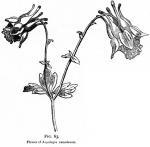 PART USED.—The entire plant Aquilegia canadensis Linn. Natural Order Ranunculaceae, Tribe Helleboreae.
PART USED.—The entire plant Aquilegia canadensis Linn. Natural Order Ranunculaceae, Tribe Helleboreae.
REMARKS.—The subject of this article is not really entitled to rank among the native medical plants. It has never been investigated for its therapeutic properties, and the only reason we introduce it is its close relationship and evidently similar properties to the Aquilegia vulgaris of Europe.
![]() The Aquilegia vulgaris, though native of Europe, is familiar in all our flower-gardens under the name of Columbine. [Common name derived from the Latin Columba, a dove. The five incurved spurs of the petals have been likened to heads of five doves; the sepals to wings. It was a favorite device of ancient artists to represent them in a ring around a dish.] It can be readily recognized, as indeed all species of the family, by the curious structure of the flowers. The flowers of most of the species are nodding. They have five flat sepals, alternating with five equal spurred petals. The spurs are very large and are the conspicuous part of the flower. The flowers of the European Columbine in cultivation vary in all shades of color from blue to white, and are often double with a series of spurred petals.
The Aquilegia vulgaris, though native of Europe, is familiar in all our flower-gardens under the name of Columbine. [Common name derived from the Latin Columba, a dove. The five incurved spurs of the petals have been likened to heads of five doves; the sepals to wings. It was a favorite device of ancient artists to represent them in a ring around a dish.] It can be readily recognized, as indeed all species of the family, by the curious structure of the flowers. The flowers of most of the species are nodding. They have five flat sepals, alternating with five equal spurred petals. The spurs are very large and are the conspicuous part of the flower. The flowers of the European Columbine in cultivation vary in all shades of color from blue to white, and are often double with a series of spurred petals.
The native plant, Aquilegia canadensis, is of wide distribution in the United States, and is found generally in rocky situations. It is a much more handsome and more graceful plant than the cultivated species and more worthy of cultivation. The flowers are bright scarlet without, yellow within, and have straight spurs. The fruit consists of five, dry capsules containing numerous black seeds and opening at the apex. The plant can be at once identified by our cut of the flower.
MEDICAL PROPERTIES.—As stated before the medical properties of the plant have never been investigated. They are no doubt analogous to the Aquilegia vulgaris of Europe, which has been used in cutaneous diseases and in jaundice. It is said to be a "diuretic, emmenagogue sudorific, antiscorbutic and aperitive. The seeds are acrid and are taken in vinous infusions for jaundice."
Drugs and Medicines of North America, 1884-1887, was written by John Uri Lloyd and Curtis G. Lloyd.

